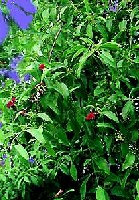View crop
View crop Data sheet EcoPortSantalum album
 |
|
| Notes |
|---|
| BRIEF DESCRIPTION A small to medium-sized evergreen glabrous tree with slender hanging branchlets. The tree can reach a height of 13-20 m and a girth of 1-2.5 m. USES An essential oil is extracted form its roots and heartwood. The oil is used in perfumes, cosmetics, and soaps and it also has medicinal properties. Tree chips are made into incense and the wood is carved into art objects. ROWING PERIOD Perennial. Flowers 3-4 years after planting and fully mature at 60-80 years. COMMON NAMES Indian sandalwood, East Indian sandalwood, Chandana, Chandan, Chandal, Sandal, Gandada, Gandha, Suket, Chandanam, Santhanam, Srigandam, Chandana, Santagu, Shrikhand. FURTHER INF Indian sandalwood is native of southern India, Sri Lanka and the Malay Archipelago. In India, it can be found at elevations between sea level and 2500 m, but flourishes best between 600 and 1000-1500 m. Sandalwood is said to be an obligate parasite and most therefore be associated with suitable hosts, if it is to survive. However, there have been suggestions that sandalwood is not necessarily an obligate parasite. Many of the species that have been identified as hosts of sandalwood are capable of fixing nitrogen. Trials have shown that host plants should not be further away than 2.2 m from the sandalwood. | Sources |
| SOURCES (Santalum album L.) Troup R 1921 pp 799-819 [USE, TEXT, RAIN, LIG, KTMP, TEMP, DRA, DEP, FER, SAL] Roecklein J 1987 pp 91 [USE] Neil P E 1990 pp 223 Coppen J 1995 pp 53-59 [USE, RAIN, LIG] |